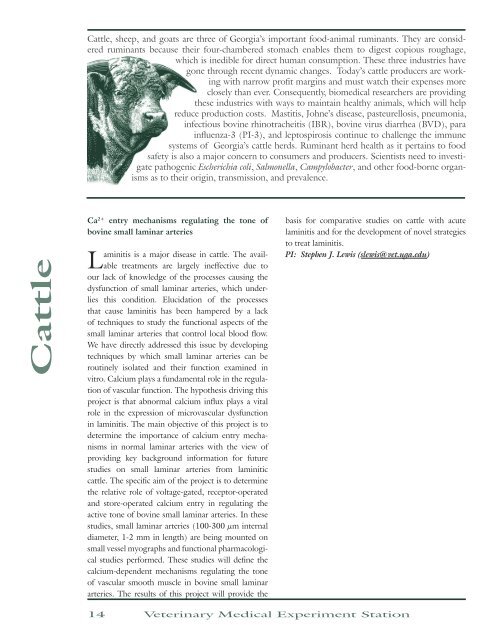Agroterrorism - University of Georgia College of Veterinary Medicine
Agroterrorism - University of Georgia College of Veterinary Medicine
Agroterrorism - University of Georgia College of Veterinary Medicine
- No tags were found...
You also want an ePaper? Increase the reach of your titles
YUMPU automatically turns print PDFs into web optimized ePapers that Google loves.
Cattle, sheep, and goats are three <strong>of</strong> <strong>Georgia</strong>’s important food-animal ruminants. They are consideredruminants because their four-chambered stomach enables them to digest copious roughage,which is inedible for direct human consumption. These three industries havegone through recent dynamic changes. Today’s cattle producers are workingwith narrow pr<strong>of</strong>it margins and must watch their expenses moreclosely than ever. Consequently, biomedical researchers are providingthese industries with ways to maintain healthy animals, which will helpreduce production costs. Mastitis, Johne’s disease, pasteurellosis, pneumonia,infectious bovine rhinotracheitis (IBR), bovine virus diarrhea (BVD), parainfluenza-3 (PI-3), and leptospirosis continue to challenge the immunesystems <strong>of</strong> <strong>Georgia</strong>’s cattle herds. Ruminant herd health as it pertains to foodsafety is also a major concern to consumers and producers. Scientists need to investigatepathogenic Escherichia coli, Salmonella, Campylobacter, and other food-borne organismsas to their origin, transmission, and prevalence.CattleCa 2+ entry mechanisms regulating the tone <strong>of</strong>bovine small laminar arteriesLaminitis is a major disease in cattle. The availabletreatments are largely ineffective due toour lack <strong>of</strong> knowledge <strong>of</strong> the processes causing thedysfunction <strong>of</strong> small laminar arteries, which underliesthis condition. Elucidation <strong>of</strong> the processesthat cause laminitis has been hampered by a lack<strong>of</strong> techniques to study the functional aspects <strong>of</strong> thesmall laminar arteries that control local blood flow.We have directly addressed this issue by developingtechniques by which small laminar arteries can beroutinely isolated and their function examined invitro. Calcium plays a fundamental role in the regulation<strong>of</strong> vascular function. The hypothesis driving thisproject is that abnormal calcium influx plays a vitalrole in the expression <strong>of</strong> microvascular dysfunctionin laminitis. The main objective <strong>of</strong> this project is todetermine the importance <strong>of</strong> calcium entry mechanismsin normal laminar arteries with the view <strong>of</strong>providing key background information for futurestudies on small laminar arteries from laminiticcattle. The specific aim <strong>of</strong> the project is to determinethe relative role <strong>of</strong> voltage-gated, receptor-operatedand store-operated calcium entry in regulating theactive tone <strong>of</strong> bovine small laminar arteries. In thesestudies, small laminar arteries (100-300 µm internaldiameter, 1-2 mm in length) are being mounted onsmall vessel myographs and functional pharmacologicalstudies performed. These studies will define thecalcium-dependent mechanisms regulating the tone<strong>of</strong> vascular smooth muscle in bovine small laminararteries. The results <strong>of</strong> this project will provide thebasis for comparative studies on cattle with acutelaminitis and for the development <strong>of</strong> novel strategiesto treat laminitis.PI: Stephen J. Lewis (slewis@vet.uga.edu)14<strong>Veterinary</strong> Medical Experiment Station
















